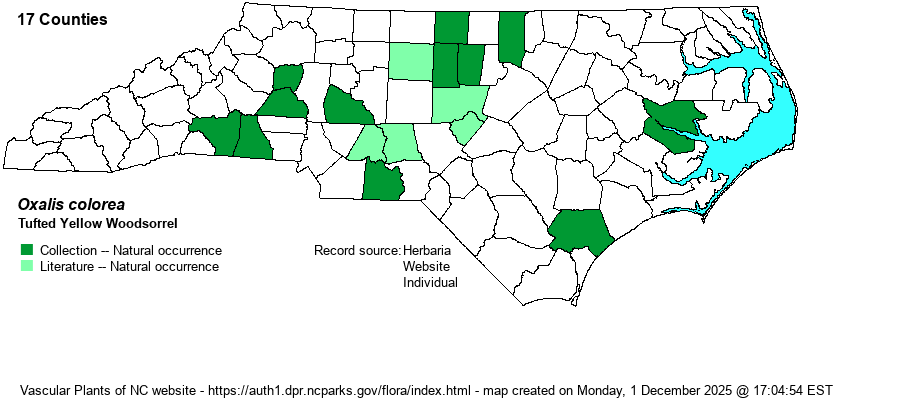| Author | (Small) Fedde | |
| Distribution | Scattered over much of the Piedmont, though rare to absent in the northwestern portions. Single records for the Coastal Plain (Beaufort and Pender counties). As the taxonomy of many or most yellow-flowered Oxalis species is evolving and muddled, it is likely the range map is incomplete. Research Grade photos on iNaturalist are included on the map, as all such records fall within the expected Piedmont range.
This is a Southern species, ranging north to eastern MD and MO, south to northern FL and LA. | |
| Abundance | Seemingly uncommon in the Piedmont, but rare in the northeastern Piedmont, and perhaps absent north and west of Catawba, Rowan, and Alamance counties. This is a Watch List species. | |
| Habitat | This species is found primarily in upland, open woods, often in dry situations such as around rock outcrops. More information on habitats is needed for NC. In VA, it is reportedly limited to woods over mafic rocks. | |
| Phenology | Blooms from March to May, rarely later; fruits soon after flowering. | |
| Identification | The many species of yellow-flowered Oxalis are quite similar to each other, with small details separating most. All are small, branched, with numerous 3-parted, clover-like leaves on long petioles, and inflorescences of bright yellow, 5-petaled flowers. This species has considerably larger flowers than the others in the Piedmont and Coastal Plain, such that the spread flower is about 1.5 inches across instead of about 3/4-1-inch across in others. Stems are generally densely spreading-hairy. This latter character will separate O. colorea from O. florida, with which it has often been included. This is a quite showy wildflower, with flowers much larger than the commonly seen woodsorrels in the Piedmont and Coastal Plain, rivalling the size of the quite showy O. grandis of our Mountain region (and the apparently historical O. macrantha from Stanly County). | |
| Taxonomic Comments | Confusing. RAB (1968) listed this taxon as a variety of O. florida, as O. florida var. recurva. The species seems to be similar to, if not confused with, O. macrantha, which had been named as O. priceae! Some references even name the entity as O. priceae ssp. colorea!
| |
| Other Common Name(s) | Small's Woodsorrel | |
| State Rank | S2? | |
| Global Rank | GNR | |
| State Status | W7 | |
| US Status | | |
| USACE-agcp | | |
| USACE-emp | | |

